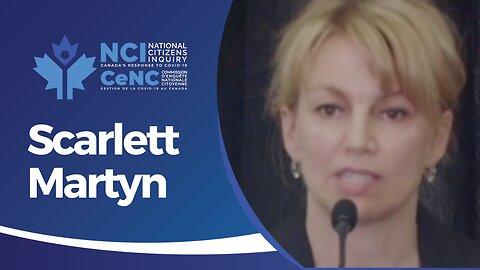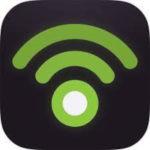Scarlett Martyn is a paramedic with 24 years experience and had natural immunity from already having caught COVID. She witnessed empty hospitals, idle personnel and her collegues turn into bullies becoming indifferent and even hostile to patients. Scarlett was terminated for “willful misconduct”.
View / Listen: Rumble|Apple Podcasts|Spotify|Google Podcasts|Podbean
[00:00:00]
Shawn Buckley
The next witness is Scarlett Martyn, and I will indicate that Scarlett is a person that has done some volunteering at the NCI. And I just bring that up because we don’t want anyone indicating bias, and so we want that out in the open that she has done some volunteering.
What she’s going to testify about today, she has testified in the past, which is videoed and available online before the NCI even existed, so I’m not concerned about her not being truthful in any way. And she’s testifying about her personal experience and we’re confident that the commissioners will find this to be helpful. Now, Scarlett, before we begin, can I ask you to state your full name for the record, spelling your first and last name.
Scarlett Martyn
Yes, it’s Scarlett Martyn, S-C-A-R-L-E-T-T M-A-R-T-Y-N.
Shawn Buckley
And Scarlett, you promise to tell the truth, the whole truth, and nothing but the truth, so help you God.
Scarlett Martyn
I do.
Shawn Buckley
Now, you had—and I’m using the past tense—but up till the COVID adventure, you had worked for 24 years as a paramedic.
Scarlett Martyn
That’s correct.
Shawn Buckley
And for part of that time, you worked as an advanced care paramedic, which enables you to deal with more critical procedures than a regular paramedic.
Scarlett Martyn
Yes.
Shawn Buckley
And in fact, advanced care paramedics are rare. I mean, a generous figure would be 10 per cent of the paramedics.
Scarlett Martyn
Yes.
Shawn Buckley
And so if there’s a 911 call involving something like a cardiac arrest, something very serious, they will try and have somebody like you attend instead of a regular paramedic.
Scarlett Martyn
That’s correct.
Shawn Buckley
And you were also on a special roster for dealing with disasters in the Greater Toronto Area. So if a big building collapsed or something like that, you were on a list to be called in.
Scarlett Martyn
Yes, I was on a heavy urban search and rescue team.
Shawn Buckley
And then when COVID hit, Orange asked if some advanced care paramedics would be willing to join their critical care paramedics to do high-level transfers, including COVID patient transfers.
Scarlett Martyn
Yes, as part of their surge capacity.
Shawn Buckley
And you volunteered for that.
Scarlett Martyn
Yes.
Shawn Buckley
And then there was a volunteer program where frontline responders were asked to participate in what was called CORSIP [COVID-10 Occupational Risks, Seroprevalance and Immunity among Paramedics], where your blood is taken on regular intervals to basically test for exposure to COVID.
Scarlett Martyn
Yes, I entered that study.
Shawn Buckley
And through that, you learned that you had natural immunity to COVID.
Scarlett Martyn
Correct.
Shawn Buckley
Which meant that you had caught COVID, and you had recovered from COVID, and you had antibodies to COVID.
Scarlett Martyn
Correct.
Shawn Buckley
Okay, and I’m going to stop leading you in a second. So you eventually got suspended for eight weeks, and then that was extended to ten weeks, and then a termination came. And I want, if you can share with the Commission, the reasons for your termination and also the process of your termination.
Scarlett Martyn
Sure. The reason for my termination was willful misconduct and for jeopardizing workplace health and safety. Previous to that, I had wrote a letter expressing my concerns to my commander, the city manager and the mayor, just expressing my reluctance to be vaccinated when I had concerns. Those concerns were met just with a couple-sentence reply, “Follow the policy.” I was suspended and then terminated.
The termination was just done through the mail. My suspension was in person and the process was quite humiliating. At one minute, you’re a valued resource, volunteering and working, volunteering to step up into a role. And the next minute, you’re being terminated. And the letter was quite vicious. I didn’t understand how it was insubordination and misconduct to ask questions, and I just wanted an accommodation. I offered to do testing or whatever it was to satisfy the safety needs. And this was at a time that we understood that vaccinated or unvaccinated could carry COVID, and I expressed my concerns.
In that meeting, I was suspended. My ambulance keys that I had drove to the meeting with were taken. My Ministry of Health ID was taken and I was drove back to the station by a supervisor to collect my belongings.
[00:05:00]
Shawn Buckley
And I just want to make sure that I understand. Because I expect that you would have shared with them that their own testing of you showed that you had natural immunity to COVID.
Scarlett Martyn
Well, it wasn’t their testing. Paramedics were offered a lot of inter-medical studies or this or that, so it wasn’t their own. But yes, I had expressed that it wasn’t unsafe for me to work, and it wasn’t protective to me with natural immunity.
Shawn Buckley
So, notwithstanding that you had natural immunity, you were terminated for not taking the vaccine for which you already were immune.
Scarlett Martyn
Correct.
Shawn Buckley
Now, I’m wondering if you can share with us what the culture was within the healthcare system at the beginning of the pandemic. So we would be talking about early 2020 and onwards.
Scarlett Martyn
At the very beginning of the pandemic— And I feel that I can really speak to this because paramedics don’t just go to one hospital, we go to many. And then I was on a team that was going to hospitals kind of all over southern Ontario. At the very beginning of the pandemic, when it was announced, the hospitals were empty. Nobody was going to the hospital; they were all too scared. That’s how people had time to do TikTok videos and such, because we weren’t working.
I was doing call after call of sudden death, which is normal for my profession. But the stories were heart-wrenching because they were people that had chest pain or stroke-like symptoms or something serious for days but they were too afraid to go to the hospital for treatment because of the pandemic. I really feel, if these patients had’ve went for treatment that they might be alive today. The public was so scared they did not want to call an ambulance.
Shawn Buckley
Right. What was the attitude within the healthcare system at the beginning, so before the vaccine is out, about whether or not it was necessary to take the vaccine? Because we all heard it was coming.
Scarlett Martyn
Yeah, it was really socially acceptable at that time in my profession to say, “Oh, I don’t think I’m going to take anything that’s rushed to market,” because we see a lot of medication recalls that were once safe, then pulled, once safe, then pulled. So yeah, it was completely within our culture accepted to say, “Oh, I don’t think I’ll take it. I don’t think I need it. I’m low-risk. I’m not in the age bracket.”
Shawn Buckley
Now, once the vaccine was rolled out, did that culture within the healthcare system change?
Scarlett Martyn
Yes. It was like a switch and it wasn’t gradual. It was just like somebody flipped a switch. All of a sudden people were jockeying in line to get vaccinated. It wasn’t acceptable anymore to say, “Well, I think I’ll wait. I don’t think this is a good idea.” As healthcare workers, we could get it before everybody else, especially those working in the frontlines, and people flooded to do so. It was hard to find people that were still reluctant to get vaccinated.
Shawn Buckley
And did you observe any change within the healthcare system after the vaccines were rolled out towards patients?
Scarlett Martyn
The changes I saw were so profound that it’s disturbing to talk to about. But I think people need to understand. I saw colleagues that I respected, that are brilliant, turn into bullies. I worked up in the ICU transferring patients. And I would hear the chatter about, “Get this one out of here. I heard they were at a rally. So look at them now. I guess it serves them right. Maybe they’ll die.” And I heard these things day in and day out. I heard them talk about— we’re in every area of the hospital, right? So there’s the acute setting and all the different settings. I would know who in those 10 beds wasn’t vaccinated because they would be sitting talking about it.
And the care they received, the part that is most disturbing is not tangible. When you care about somebody, the way you interact with them, you put your hand on their shoulder, you move them gently. When you have hostility towards them, your chart still looks fine. You’ve still given them all the things you were supposed to do. But the way they were handled was different. It was rougher. You could feel the aggression.
[00:10:00]
And it was completely acceptable for them to sit around and talk about the anti-vaxxers that should just all die. “I don’t want anti-vaxxers getting health care.” “Why would the anti-vaxxers come up to the ICU?” “If the anti-vaxxers don’t want to take the vaccine, maybe we shouldn’t give them morphine for their broken leg.” It just went on and on. I witnessed my own colleagues on 911 calls badgering elderly patients that weren’t vaccinated. It had nothing to do with why we were there.
We’re called on people’s worst moments in their life, so we have to be mindful of that. But I’ve seen them standing there instead of treating what was needed to be treated— And not always life threatening, they just needed something. They would say, “Well, what do you mean you’re not vaccinated? It’s been available. What would your reason be for not being vaccinated?” And if we can picture a towering person in a uniform in a position of authority talking this way to an 86-year-old lady lying on her couch with her stomach hurting, badgering her, it was absolutely appalling.
Shawn Buckley
You had given me an example when we were talking about a call that seemed to you to be a vaccine adverse reaction, where a lady had a shot and then she developed tachycardia and chest pain. Can you tell us about that call? Because I think it speaks to the change in culture.
Scarlett Martyn
Absolutely. I don’t know if I remember that specific one but there’s many. So in the field our job is to report what you tell us and then ask you more questions if we need to know them. Take a medical history. So it’s not our job to judge what we really think you’re telling the truth on. We just report it. When we would take these patients to the hospital and I would talk to the triage nurse for intake and I’d say, “This patient had chest pain after the vaccination. They’re quite worried that it’s a reaction. They’re tachycardic,” which is high heart rate, and being high as in 140 beats a minute—like, not just a little elevated with chest pain. The nurses would roll their eyes and huff and puff and go, “Oh great, we got another one,” you know, “Great, yeah, add that to the list.”
I can watch them because I stand behind where they’re reporting. It never gets typed in. What we say never got typed in for those patients. I never saw a single one say, “following vaccination.” And these patients were wrote off many times with anxiety. Sadly, as paramedics, because of the health protection laws, we don’t have an ability to follow patients beyond the emerge. So if they get admitted up to a medicine floor, we can’t call them up and go up and see them. So I don’t know the long-term outcome of these patients.
Shawn Buckley
Now, you were telling us earlier that when the pandemic started, it was slower. Can you give us some more details about that?
Scarlett Martyn
Yeah. I’ve worked in a busy city, so we don’t get a lot of downtime. It’s rare to have a lunch break. We do a lot of end-to-shift overtime. So it’s really, really rare for us to spend time in our station socializing or cooking. But at the pandemic, that was right at the beginning, it was just like everything got shut off. We were in the stations; we were watching movies; we were hardly doing any calls. And sadly, when we did get called out, it was usually a person that really should have called much earlier.
I remember feeling embarrassed when you’d get a knock on the ambulance door and it would be a restaurant owner delivering food to the health care heroes. And at seven o’clock at night in Toronto, people would come out and bang pots and pans. And we’re not heroes, right? We signed up to do a job. And pandemics are always part of health care. We’re all trained in it, right? We have PPE.
Shawn Buckley
Right. And you’re describing to us—in any event at the beginning, it was slower than usual.
Scarlett Martyn
So much slower. Like, I was watching movies at work—series of movies.
Shawn Buckley
And had that ever happened before?
Scarlett Martyn
It had happened once before. With SARS. That was the only other time. And that only lasted—
[00:15:00]
The call-volume drop didn’t last long.
Shawn Buckley
Now, I want to switch to a different topic. Because my understanding is, at the beginning of the pandemic, when we’re all for the first time seeing all these numbers on TV of how many cases we have, that actually these cases at the beginning were not being based on things like PCR tests – in large part because they just weren’t available yet. The system was having to gear up and get testing kits to the hospital. So can you share with us basically how would they classify somebody as a COVID case at the beginning?
Scarlett Martyn
Yeah. At the very beginning there wasn’t the ability to do a swab, send it, have it back. There was no rapid tests readily available. So we would do a screening on a patient, which was just a sheet with 10 or 15 checkboxes. And those would be the inclusion criteria for suspected COVID—so just suspected. And these things would be like, abdominal pain, recent travel, and they changed almost every day. So you would have a checkbox: Have they traveled recently? Do they have vomiting, diarrhea, fever? Do they feel more tired than usual? Do they have pink eye? Many, many, many. And the list kept getting longer.
It’s hard to find a patient that isn’t more tired than usual, doesn’t have any of this long list, so they would fail. So the fail would put them in a suspected COVID positive category. One patient I had had been in an assault and he had been whacked over the head with, I think, a bottle. Well, he had a headache naturally. We brought him in for assessment for a headache, and the nurse was filling it out. Once they screen positive, they have to try to find isolation. And I said, “We don’t need isolation for this. This guy’s headache started from the hit on the head.” “Well, I know, but we can’t override it.” There’s no professional opinion, so they couldn’t override. So you had massive amounts of patients being categorized as probable COVID patients.
Shawn Buckley
And those patients then would also end up in COVID wards, which would be reported as full.
Scarlett Martyn
Some of them were just in-and-out emerge. patients and we lack the ability to really follow where they went.
Shawn Buckley
So just so I understand, let’s say somebody’s at the bar and they get in a fight and they get hit in the head. And they go to the hospital and say their head hurts. The screening nurse or person would have no discretion; that person would be listed as a suspected COVID case.
Scarlett Martyn
Yeah, because it’s not on pen and paper anymore. It’s an input into a computer. And I argued—well, not rudely—but I said, “This is silly. Like, this is—how could we possibly? Like, he didn’t have a headache before; the headache started now. He’s well. He has no other symptoms.” “No, I know, but it won’t let me check. And there’s no field to add in professional opinion.” So they just got all filtered.
I mean, it was really hard to find a patient that called an ambulance that would pass a screening.
Shawn Buckley
So are you saying that early on in the pandemic then, before they had rapid testing, almost every single patient brought in by ambulance likely would be screened as a potential positive?
Scarlett Martyn
Oh, yeah. It was a joke that maybe you could stub your toe and pass. If you only called for a stubbed toe, you could maybe pass the screening.
Shawn Buckley
Now you had a troubling experience where an inmate was admitted because of a headache. Can you share with us that story?
Scarlett Martyn
Yeah. All of these new procedures caused massive delays in patient care. And sometimes these delays cost people their life. Every hospital had a slightly different procedure for screening. I remember transferring a young gentleman and he had an arterial brain bleed. Time is never as valuable as it is when you’re bleeding inside your brain from an artery and we were rushing him to one of the neurosurgery centers.
His condition started to deteriorate before we arrived, so the emerge. had sedated him and intubated him for transport. This was a gentleman that walked into the hospital with a severe headache. He passed the screening at the hospital, that would have been before a headache was added. So these screenings changed constantly, right? They would add in.
[00:20:00]
So he passed the hospital screening. And at the receiving hospital where he was to get treatment, he didn’t pass the screening anymore because he couldn’t answer questions.
Shawn Buckley
So I’m just going to stop you so people aren’t confused. He goes to hospital number one with a headache. He’s admitted at hospital number one, they determine that he’s bleeding in his brain.
Scarlett Martyn
Yeah.
Shawn Buckley
And that’s a life and death emergency surgery situation.
Scarlett Martyn
Yes.
Shawn Buckley
But that hospital doesn’t do that emergency surgery, so it’s arranged for you guys to transport him quickly to hospital number two.
Scarlett Martyn
Yes.
Shawn Buckley
But because time is so sensitive, hospital number one sedates him and intubates him so that the second hospital doesn’t have to waste time doing that. It’s an emergency.
Scarlett Martyn
Yeah, it is that. It’s hard for us to do in the field. We can, but he was deteriorating so it was for airway protection if he deteriorates. Yeah.
Shawn Buckley
So now he’s sedated by hospital number one and can’t answer questions. And he arrives at hospital number two. And tell us again, what happened in hospital number two?
Scarlett Martyn
We have his screening from hospital number one in the charts. We have all the information we need and they stop us because, well, he fails the screening. And they’re not really sure what to do now because they had him as a “passed screening” and now he fails. You know how things work: Nobody knows. Calls are made. Calls go up the chain, down the chain. We need another room. We need this. We need that.
And the clock is running and we’re desperately trying to advocate for this patient to just go in. Let’s just get the show on the road! And that delay continued on for a half an hour if not 40 minutes.
Shawn Buckley
And in your experience, what is the likely prognosis following a delay at screening for up to 40 minutes when somebody’s brain is bleeding?
Scarlett Martyn
It’s a very poor prognosis. It’s not likely survivable with any quality of life.
Shawn Buckley
And do you think it’s possible that could have then also been classed as a COVID death?
Scarlett Martyn
We did witness in the field strange things with classifications of COVID death, so it absolutely would not surprise me.
Shawn Buckley
Can you share with us some types of things that you saw being classed as COVID deaths?
Scarlett Martyn
Yes, I’ll try to keep it— We were doing shift change one morning, so the night crew goes off, the day crew comes on. We take a report from the night crew. They had just come from a jumper and we said, “Well, we’ll help you clean things up.” It was just around the corner. It was from an eight-story building and they had told us about the call. There really wasn’t anything left to transport.
Later that day, my partner and I received a call from Public Health that the patient, early that morning from that address, had been swabbed for COVID and tested positive. We looked back and I said, “Oh, that was the night crew that had the jumper.” And I said, “I don’t understand. What would you swab? Like, did you bring a spatula? This doesn’t make any sense. That patient wasn’t in a condition to swab.” But they assured me that that was a COVID-positive case. You certainly don’t have to have medical training to understand the cause of death from jumping out an eight-story building.
Shawn Buckley
Now, switching the gears again. After your experience of being terminated, you helped form a group called the United Health Care Workers of Ontario?
Scarlett Martyn
Yes.
Shawn Buckley
And my understanding is that group has over 3,000 healthcare workers as members.
Scarlett Martyn
Yes, just in Ontario.
Shawn Buckley
Oh, I guess it is the Healthcare Workers of Ontario. Do you have members from other provinces?
Scarlett Martyn
No.
Shawn Buckley
Okay. So you guys had taken various initiatives with the provincial government. But I’m wanting to share with us an initiative that was taken by the United Health Care Workers of Ontario concerning the federal government. You guys sent a letter to the Minister of Health.
Scarlett Martyn
Yes, we did.
Shawn Buckley
Can you just share with us why you guys sent that and what happened in response to that?
[00:25:00]
Scarlett Martyn
We had concerns on the frontlines with many, many things. One of our issues, biggest concerns, were around informed consent. And we believed that the public wasn’t getting informed consent. They weren’t getting informed consent about the risk of the COVID virus. We think that there is misrepresented data. We believe that there is a lot of fear, which led to people rushing out to get vaccinated and not understanding the new platform, the mRNA platform. We don’t believe that anybody sat down and talked about the risk–benefits. And every medical procedure given is always, 100 per cent of the time, based on risk–benefit. And this was just a very one-size-all approach.
We approached them in our letter. And we had several questions, specific questions, that we wanted answered. And we even petitioned them in a letter. We had some of the top scientists across Canada help us form a vaccine safety-risk statement. So just like with any new pharmaceutical, a risk statement: “Might cause this, might cause that. We don’t know about mutagenicity.” Because there’s nothing like that currently on the COVID vaccination. And we felt that that was important, not just for health cares, but for all Canadians to understand.
Shawn Buckley
And is it fair to say that you thought that such a letter and a safety-risk statement written by professionals and backed by 3,000 healthcare providers would warrant a response from the federal Minister of Health and Ms. Tam?
Scarlett Martyn
Absolutely. And we also got signatories of other public interest groups, so that we could present it. This isn’t a small group of Canadians that want these answers. This isn’t just healthcare. This is Canadians.
Shawn Buckley
And did you get a response?
Scarlett Martyn
No.
Shawn Buckley
And Commissioners, I’ll advise you that that letter will be entered as an exhibit and available to you for your consideration [Exhibit TO-21]. And Ms. Martyn, I’ll just ask the commissioners now if they have any questions for you.
No questions. Scarlett, on behalf of the National Citizens Inquiry, I’d like to thank you sincerely for testifying today.
Scarlett Martyn
Thank you.
[00:27:51]
Final Review and Approval: Jodi Bruhn, August 16, 2023.
The evidence offered in this transcript is a true and faithful record of witness testimony given during the National Citizens Inquiry (NCI) hearings. The transcript was prepared by members of a team of volunteers using an “intelligent verbatim” transcription method.
For further information on the transcription process, method, and team, see the NCI website: https://nationalcitizensinquiry.ca/about-these-transcripts/
Summary
Scarlett Martyn is a paramedic with 24 years experience, and unique skills as an advanced care paramedic and part of a heavy urban search and rescue team. She entered a paramedic focused study (CORSIP) that confirmed she had natural immunity from already having caught COVID.
She was suspended and then terminated for “wilful misconduct” and “jeopardizing health and safety” for refusing to take the COVID (experimental) vaccine. She confirms that Ontario Health was aware at the that the vaccinated could also transmit the virus.
She witnessed empty hospitals and idle personnel at the beginning of the pandemic – and they were so slow that she sat and watched movies most of the day. The public delayed calling ambulances due to fear of the coronavirus. Her colleagues turned into bullies and unsympathetic and even hostile towards unvaccinated patients, with even talk of how the unvaccinated patients “deserved” to be there and die.
She witnessed hospital staff regularly failing to add a comment that (chest pain, elevated heart rate) was immediately following vaccination. She gave examples of improper and false reporting of death.
She founded United Health Care of Ontario, and sent a letter with other groups to the federal Minister of Health and Theresa Tam, with the help of (3000) including top Canadian scientist and doctors, with concerns and a safety-risk statement, but received no response.






















